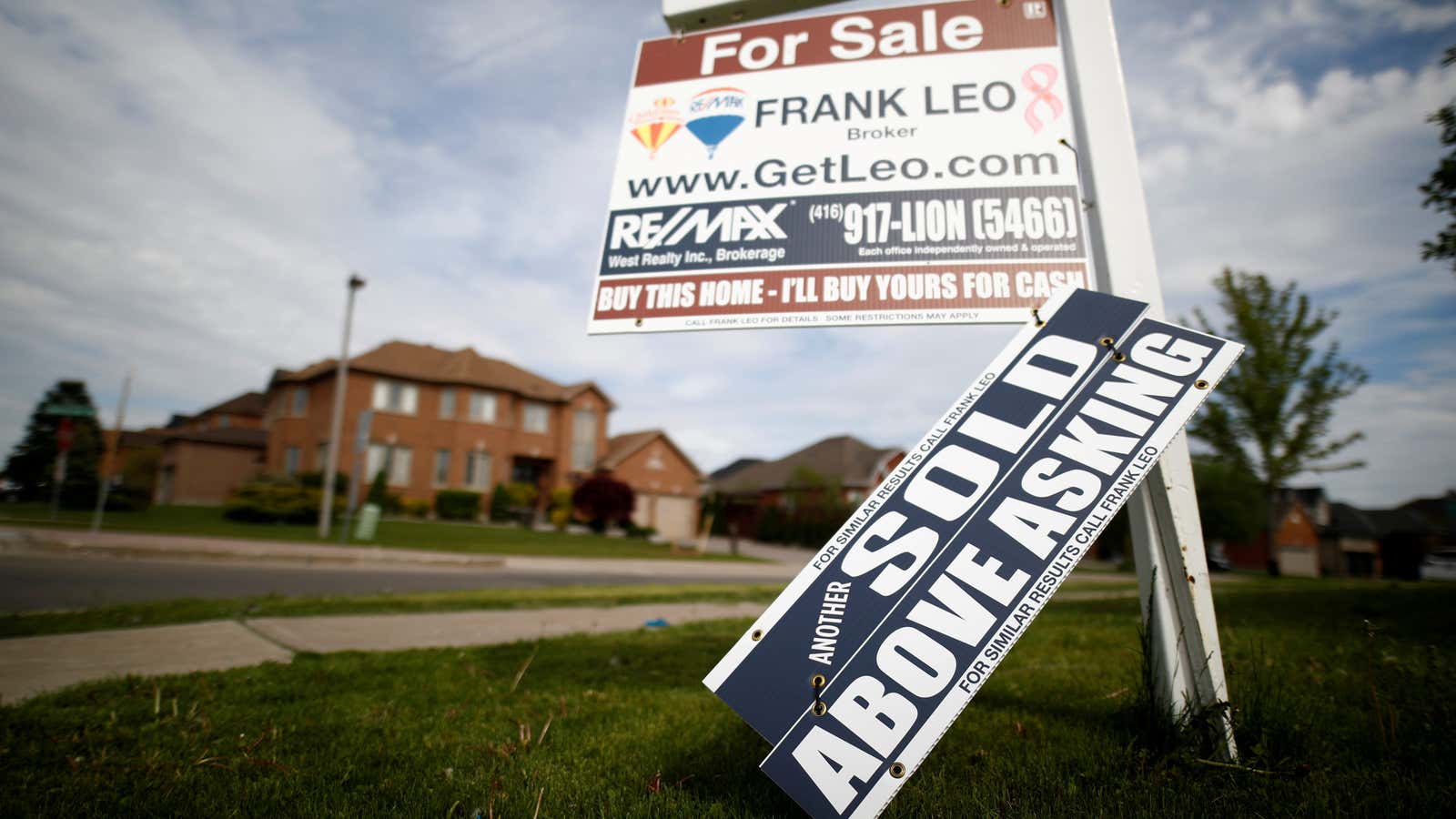The US housing market is still in a frenzy as pandemic-induced demand intensifies a longstanding housing shortage. In October, the number of existing homes sold across the country rose by 0.8% even as home prices kept increasing. After 15 straight months of rising prices, the median price for a home in the third quarter of 2021 hit $404,700, up nearly 20% from the year before.
The press has noted that more than 6 million homes may be sold this year, more than any time since 2006. For those familiar with real estate busts, this may be an ominous sign. A roughly three-year housing boom ended in 2008 year as real estate prices plummeted, ultimately sparking the global economic meltdown known as the Great Recession. As much as $16 trillion of home value got wiped out.
Economists argue this time is different. Tight supply and rising demand—not lax lending standards—are driving the current boom. So while the housing market in 2006 was a bubble waiting to pop, this one appears to reflect the entry of a new generation of buyers into the market, and the plausibly long-lived disruptions of a global pandemic.
What’s not happening: A housing bubble
In large part, the previous housing crash was driven by an unprecedented wave of subprime lending (which was itself spurred by a demand for mortgages among investors). Exceptionally risky mortgages with high, often variable, interest rates were offered to borrowers with poor credit histories. By 2006, 20% of US mortgages were subprime (pdf). When home values went down, many of these borrowers defaulted, triggering a systemic collapse.
Economists aren’t concerned about a repeat of the previous housing crisis, partly because the fundamentals of mortgage lending are much stronger this time around. Today, subprime lending is much less common, thanks in part to federal regulation that has set stricter standards. Between 2009 and 2014, subprime mortgages only made up around 1% of all US mortgage originations.
Jeff Taylor, a board member at the Mortgage Bankers Association who has more than 20 years of experience in the mortgage industry, says that loan products and underwriting guidelines no longer allow for borrowers to take as much risk.
“There is a lot of skin in the game and ability to repay is a large consideration,” he says.
High home prices this time reflect real demand
Robust demand is another reason the current housing market is unlikely to collapse anytime soon. The number of Americans who can reasonably afford a home, and are now looking to buy one, is rising even while inventory remains stagnant. The pandemic contributed to this in three ways: the number of new homes coming onto the market slowed as existing homeowners decided not to sell; emergency federal protection allowed people who had lost income to pause mortgage payments for a time, and supply chain and labor shortages left builders scrambling to get new houses up fast enough to meet demand.
All of this indicates that high prices reflect real demand by homebuyers, not just a speculative bubble. More Americans just want new homes, and are equipped to properly finance them, at a time when few are available.
Millennials are finally buying homes
A big part of the demand equation is that Americans between the ages of 25 and 40 are finally buying homes in numbers mirroring that of earlier generations. The Great Recession of 2008 and 2009 had delayed home-buying dreams for many millennials who entered a difficult job market and lost the ability to build savings early. Because many couldn’t afford to buy homes, they weren’t built, says Taylor, who is also founder and director of Mphasis Digital Risk, a mortgage servicing firm.
“There were probably 6 million houses between 2008 and 2013 that should have been built, but weren’t because millennials weren’t buying. So that brings us to today, where there are millions of homebuyers who can’t find houses because they’re just not out there.”
Even though homeownership remains out of reach for many millennials (only 42% of millennials own homes, versus 48% of Gen Xers and 51% of boomers) they now represent the largest segment of Americans entering the home-buying market. Millennials are earning more money and starting families later than their predecessors, but they’re finally here, and they’re looking for houses.
All of this means that what looks like an exceptionally active housing market is actually just the beginning of a generational shift. While this demand was likely always coming, the shifting incentives of the pandemic, as well as low interest rates making more financing available, sped things up.
What will happen to US home prices from here?
Taylor predicts that home prices, as well as the rate of home buying, will not slow down or return to “normal” anytime soon. He expects to see 4.5 million mortgages originated in 2022, and an annual increase in home prices of between 5% and 13% over the next three years. This will pose a challenge for those trying to enter the home-buying market for the first time, but it means the market as a whole is likely to stay strong.
Correction (Nov. 29): An earlier version of this article incorrectly referred to Jeff Taylor as a former board member of the Mortgage Banker Association. He is still on the board.
